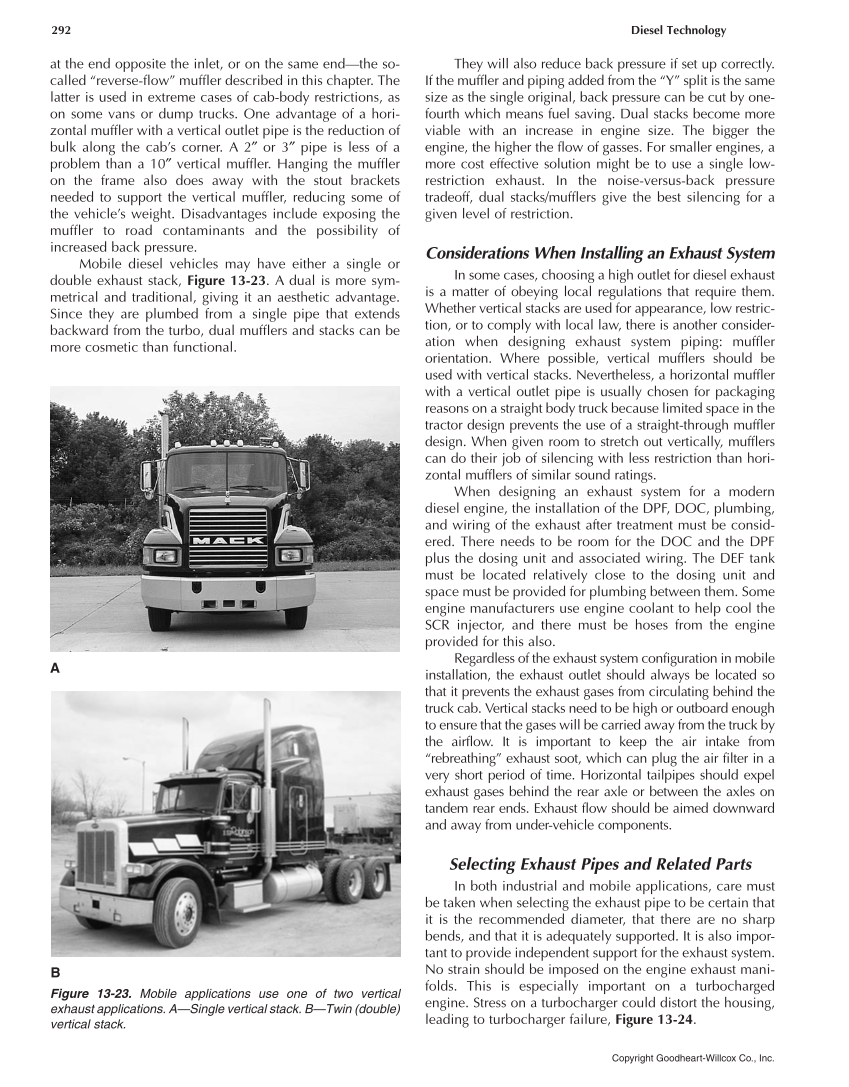292 Diesel Technology Copyright Goodheart-Willcox Co., Inc. at the end opposite the inlet, or on the same end—the so- called “reverse-flow” muffler described in this chapter. The latter is used in extreme cases of cab-body restrictions, as on some vans or dump trucks. One advantage of a hori- zontal muffler with a vertical outlet pipe is the reduction of bulk along the cab’s corner. A 2″ or 3″ pipe is less of a problem than a 10″ vertical muffler. Hanging the muffler on the frame also does away with the stout brackets needed to support the vertical muffler, reducing some of the vehicle’s weight. Disadvantages include exposing the muffler to road contaminants and the possibility of increased back pressure. Mobile diesel vehicles may have either a single or double exhaust stack, Figure 13-23. A dual is more sym- metrical and traditional, giving it an aesthetic advantage. Since they are plumbed from a single pipe that extends backward from the turbo, dual mufflers and stacks can be more cosmetic than functional. They will also reduce back pressure if set up correctly. If the muffler and piping added from the “Y” split is the same size as the single original, back pressure can be cut by one- fourth which means fuel saving. Dual stacks become more viable with an increase in engine size. The bigger the engine, the higher the flow of gasses. For smaller engines, a more cost effective solution might be to use a single low- restriction exhaust. In the noise-versus-back pressure tradeoff, dual stacks/mufflers give the best silencing for a given level of restriction. Considerations When Installing an Exhaust System In some cases, choosing a high outlet for diesel exhaust is a matter of obeying local regulations that require them. Whether vertical stacks are used for appearance, low restric- tion, or to comply with local law, there is another consider- ation when designing exhaust system piping: muffler orientation. Where possible, vertical mufflers should be used with vertical stacks. Nevertheless, a horizontal muffler with a vertical outlet pipe is usually chosen for packaging reasons on a straight body truck because limited space in the tractor design prevents the use of a straight-through muffler design. When given room to stretch out vertically, mufflers can do their job of silencing with less restriction than hori- zontal mufflers of similar sound ratings. When designing an exhaust system for a modern diesel engine, the installation of the DPF, DOC, plumbing, and wiring of the exhaust after treatment must be consid- ered. There needs to be room for the DOC and the DPF plus the dosing unit and associated wiring. The DEF tank must be located relatively close to the dosing unit and space must be provided for plumbing between them. Some engine manufacturers use engine coolant to help cool the SCR injector, and there must be hoses from the engine provided for this also. Regardless of the exhaust system configuration in mobile installation, the exhaust outlet should always be located so that it prevents the exhaust gases from circulating behind the truck cab. Vertical stacks need to be high or outboard enough to ensure that the gases will be carried away from the truck by the airflow. It is important to keep the air intake from “rebreathing” exhaust soot, which can plug the air filter in a very short period of time. Horizontal tailpipes should expel exhaust gases behind the rear axle or between the axles on tandem rear ends. Exhaust flow should be aimed downward and away from under-vehicle components. Selecting Exhaust Pipes and Related Parts In both industrial and mobile applications, care must be taken when selecting the exhaust pipe to be certain that it is the recommended diameter, that there are no sharp bends, and that it is adequately supported. It is also impor- tant to provide independent support for the exhaust system. No strain should be imposed on the engine exhaust mani- folds. This is especially important on a turbocharged engine. Stress on a turbocharger could distort the housing, leading to turbocharger failure, Figure 13-24. Figure 13-23. Mobile applications use one of two vertical exhaust applications. A—Single vertical stack. B—Twin (double) vertical stack. A B
